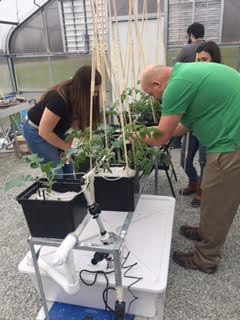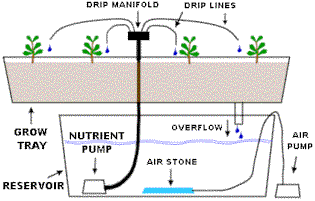Keep it green, keep it clean – greenhouse up and running


Last year the Southmoreland School District received a grant from Chevron for STEM education. And now, that money has been materialized into a greenhouse. But under the metal frame and glass is the teachings of “one of the best classes with regards to investment.”
Mr. Larry Ansell’s students have seen the “real world experience of how people have to come together to make something happen.”
“I’ve had everything from students turning wrenches to students reading directions,” said Mr. Ansell regarding the construction of the greenhouse.
This is the hands on work that a lot of students don’t often receive.
“It’s different because we get to learn through experience rather than notes and a test like all my other classes,” said junior Hannah Clark. “Mr. Ansell never comes right out and gives you an answer. He helps you reason through the problem.”
And even though the crew has had their share of problems, Mr. Ansell believes that his students are “genuinely concerned” about the well-being of the greenhouse.
“You really don’t need that much to keep a plant alive,” said senior Mikayla Lewandowski. “I’ve seen people have plants in a tin can.”
But Southmoreland’s Biotechnology class is going beyond this
The greenhouse utilizes the hydroponics drip irrigation system that is “probably the most widely used type of hydroponic system in the world.” At its basics, a timer controls a submersed pump that releases a drip of nutrient solution to each plant. The excess solution is collected back into the reservoir to be reused, much like the image below.

“We were supposed to take a picture of the plants and measurements each day to see how they were doing and then do a time lapse,” said Lewandowski.
But the recent setback of Chromebook distribution changes the process of this project. Now, students are journaling about the number of leaves, height, color of plants, etc. on old school pencil and paper.
“When we get Chromebooks, I have sensors to plug into the laptops or to project to the whole class,” said Mr. Ansell. Things that would be recorded with the sensors are PH level, humidity, and the temperature inside and outside of the greenhouse. This enables the students to “see what conditions plants do well in.”
A raft aquaponics system is being planned as another way to nourish plants where they are grown on polystyrene boards (rafts) that float on the water. The continuous water flow will be pumped from a seventy gallon tank that contains the fish to another container with the plants. The fish’s waste in the water will enable the plants to be “free of additional fertilizer.”
In the short run, students may take home the produce or make food out of it in class. But more students than just those who are in this class could benefit from the natural produce.
Mr. Ansell’s “ideal situation” would be for students to harvest the produce in the morning, bring it to the cafeteria, and be able to use that produce in the school lunches.
“I think it’s a great idea,” said Clark. “Mr. Ansell mentioned it before and hopefully it will happen.”
Bailey Geehring
"Be a rainbow in someone else's cloud"- Maya Angelou
Latest posts by Bailey Geehring (see all)
- Opioid crisis tears apart local family - May 22, 2017
- Primary center autistic support classroom practices transition skills with high school students - May 3, 2017
- Scotties to face Avonworth Saturday in first round of WPIAL playoffs - February 15, 2017
Leave a comment